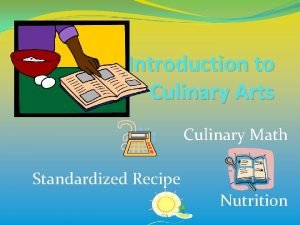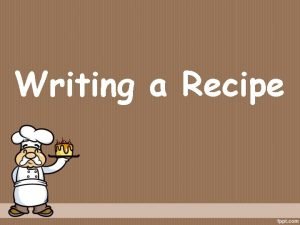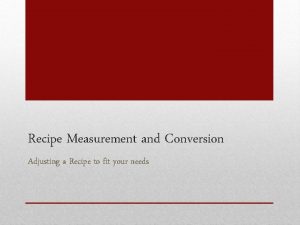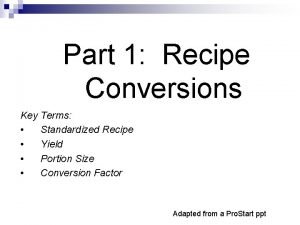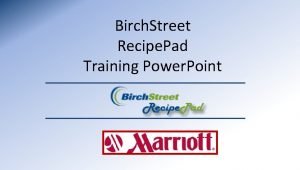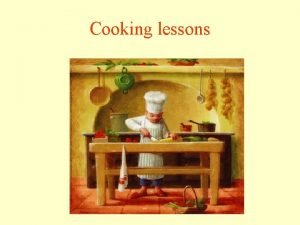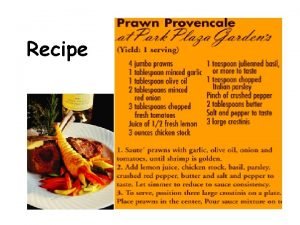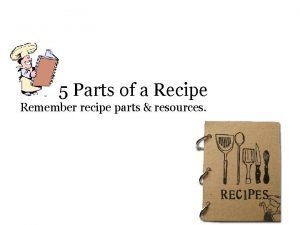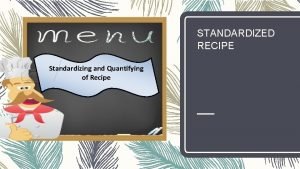Getting the Most From Your Recipe How To











- Slides: 11

Getting the Most From Your Recipe

How To Follow a Recipe • Before you start, read the recipe from start to finish so there are no surprises. • Preheat the oven to the correct temperature so that it is ready when you need it. • Before actually starting to cook or bake, gather all the necessary ingredients and equipment. Prepare the ingredients according to the directions in the ingredients list. • For determining doneness, always rely first on the recipe’s sensory descriptor, such as “cook until golden brown”. Consider any times given in a recipe merely as a guide for when to start checking doneness.

Ingredients • Unless otherwise noted, assume that. . . • eggs are large (about 60 ml [2 oz]) • flour is unbleached, all-purpose (don’t sift unless directed to do so) • sugar is white, granulated (table sugar) • fresh herbs, greens, and lettuces are washed and dried • garlic, onions, and fresh ginger are peeled

Watch Those Modifiers! • A recipe ingredient list contains words such as “diced” and “chopped” that tell you how to prepare each ingredient for the recipe. • However, what you may not realize is that the placement of these “preparation modifiers” in the ingredient line is as important as the modifier itself. • For example: • 1 cup rice, cooked: measure out a cup of rice, and then cook it • 1 cup cooked rice: measure out a cup of already cooked rice

https: //www. youtube. com/watch? v=r. Ck. Os. VMFO 4 o

Recipe Components • Specific Ingredients • listed in order of use • includes how to prepare them (eg. , cheddar cheese, grated) • Exact Amounts • includes units (metric, Imperial, or both) • Directions • step by step instructions • Temperature and Cooking Time • you are often instructed to preheat at the beginning of directions • use the cooking time as a guideline; check often for doneness

Recipe Components • Yield • amount that will be produced by the recipe • may be in number of servings • Nutritional Information • number of calories, fat content, etc. • Variations/Suggestions • ingredient substitutions (ie. , substitute blueberries for chocolate chips) • additional ingredients (ie. , optional ingredients) • serving suggestions (ie. , serve with warm bread)

Recipe Formats • Standard Format • most common format • takes up the least space • ingredient list is a quick reference to determine if they are on hand • ingredient list is listed in order of use • easy to follow – step by step instructions follow ingredient list

Recipe Formats • Narrative Format • written in paragraph form, giving ingredients along with method • works well for short recipes with few ingredients

Recipe Formats • Active Format • step by step method that is easy to follow • takes up more space • checking ingredients is not as easy as in standard format

 The secret of getting ahead is getting started
The secret of getting ahead is getting started 3.05 getting the most for your money
3.05 getting the most for your money Your most unhappy customers are your greatest
Your most unhappy customers are your greatest 6 parts of a standardized recipe
6 parts of a standardized recipe Give us your hungry your tired your poor
Give us your hungry your tired your poor Hình ảnh bộ gõ cơ thể búng tay
Hình ảnh bộ gõ cơ thể búng tay Lp html
Lp html Bổ thể
Bổ thể Tỉ lệ cơ thể trẻ em
Tỉ lệ cơ thể trẻ em Voi kéo gỗ như thế nào
Voi kéo gỗ như thế nào Chụp phim tư thế worms-breton
Chụp phim tư thế worms-breton Chúa sống lại
Chúa sống lại



